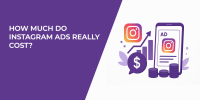Facebook and Instagram are among the most powerful platforms for event marketing. Facebook Events alone are used by over 700 million people each month. Meanwhile, Instagram’s visual-first format helps build excitement and anticipation around upcoming gatherings. Together, these platforms give businesses an unmatched opportunity to combine reach with engagement.
According to Meta, event-related posts and ads often see higher engagement rates compared to non-event content, with some campaigns reporting lifts in attendance by 20–25% after integrating paid promotion.
Step 1: Set Up a Facebook Event Page
Creating an official Facebook Event is the foundation of your promotion strategy.
-
Include clear event details: date, time, location, and description.
-
Add eye-catching visuals that represent the theme.
-
Use keywords in your event description so it shows up in relevant searches.
A well-crafted Facebook Event can increase organic discovery since users often get notifications when their friends show interest.
Step 2: Promote Across Instagram
Instagram complements Facebook by amplifying reach through visuals and stories.
-
Share behind-the-scenes content leading up to the event.
-
Use Stories polls and countdown stickers to drive interaction.
-
Highlight user-generated content from past events to build credibility.
Research shows that Instagram Stories ads drive higher engagement rates, with completion rates exceeding 70% for interactive formats.
Step 3: Use Targeted Ads to Boost Attendance
Paid promotion ensures your event reaches the right people.
-
Target by interests, behaviors, and lookalike audiences.
-
Retarget website visitors or past event attendees.
-
Split test ad creatives to see which message drives more responses.
Advertisers who run targeted campaigns before events often see cost per RSVP drop by up to 20% compared to generic audience targeting.
Step 4: Engage Before, During, and After
Promotion isn’t just about getting people in the door. It’s about building relationships.
-
Before: Share teasers and reminders.
-
During: Post live updates and Stories to encourage last-minute attendance.
-
After: Share highlights, photos, and thank-you posts to keep momentum going.
This ongoing engagement helps strengthen community and sets the stage for future event success.
Final Thoughts
Promoting events on Facebook and Instagram doesn’t have to be complicated. By combining Facebook Events, Instagram engagement, and targeted ads, you can simplify the process while maximizing your results. Consistency and creativity are the keys to cutting through the noise and getting people excited to attend.

